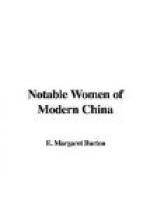During 1907 the work continued to grow steadily in scope and favour. Dr. Kahn’s annual report for that year shows something of its development: “My practice has increased steadily among the foreigners and Chinese, until now we have patients come to us from all the large interior cities, even to the borders of Fuhkien. You would be surprised to know how many foreigners I treat in this out-of-the-way place. During the year we have treated over eight thousand patients. The evangelistic work among them has been better undertaken than ever before, and I am sure we shall see results in the near future. Several inquirers have been accepted, and seven women have been taken in as probationers.”
Although the demands of her work in Nanchang are constant and absorbing, Dr. Kahn has never become provincial in her interest; while working with whole-hearted devotion in her own corner, she still keeps the needs of the entire field in mind. At the fifth triennial meeting of the Educational Association of China, held in Shanghai in the spring of 1905, she gave an address on “Medical Education,” in which she said in part:
“Turn the mind for a moment to the contemplation of China’s four hundred millions, with the view of inaugurating effectual modern medical practice in their midst. How many physicians are there to minister to this vast mass of humanity? Barely two hundred! Such a ratio makes the clientele of each physician about two million. What would the English-speaking world think if there were only one physician available for the cities of New York and Brooklyn! Yet the people of these cities would not be so badly off, because of the steam and electrical connections at their command.”
“We as missionary physicians recognize our own inadequacy and the imperative demand for native schools. How can we undertake to help spread medical education in China with the limited means at our command? Shall we simply take unto ourselves a few students as assistants, and after training them for a few years turn them out as doctors? By all means, no! Take us as we are generally situated, one or two workers in charge of a large hospital or dispensary, is not the stress of our professional work almost as much as we can bear? Then there are the people to whom we ought to give the bread of life as diligently as we minister to their bodily needs. Add to this the urgent need of keeping up a little study. Where comes the time and strength to teach the students as they should be taught? Certainly to the average missionary such work as the turning out of full-fledged doctors ought to be debarred. It seems to me that what can and ought to be done is to single out promising students who possess good Christian characters as well as physical and mental abilities, and send them to large centres such as Peking, Canton, Shanghai, and Hankow, where they might take a thorough course in medicine and surgery. In these large cities




